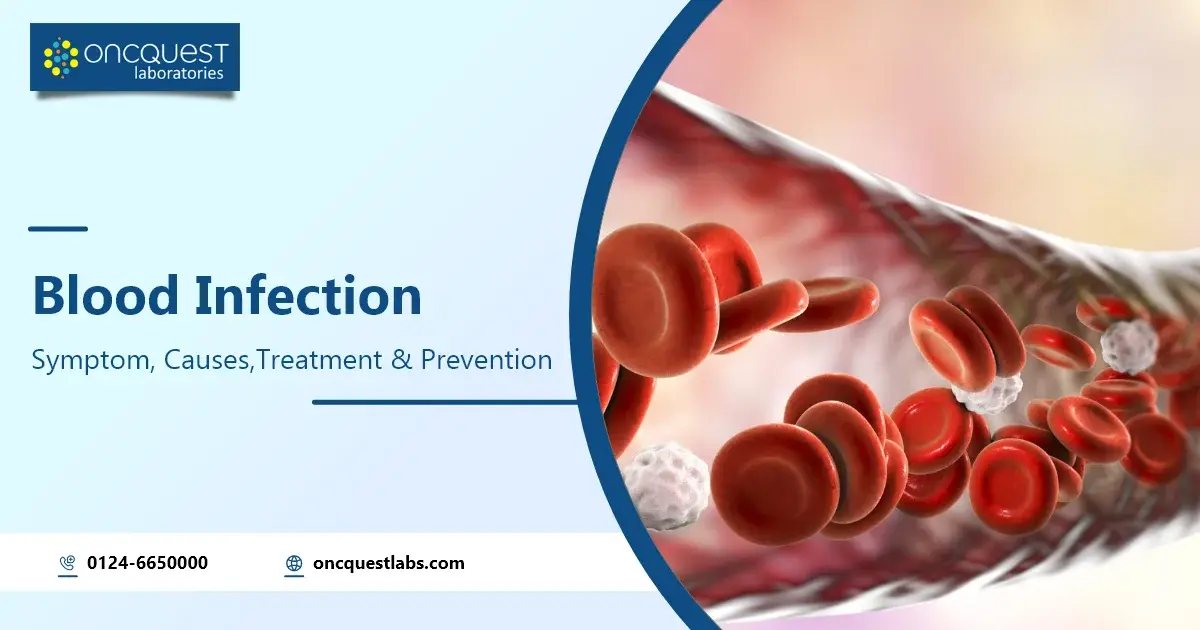In the intricate dance of our biological systems, the bloodstream plays a central role, carrying the essence of life to every corner of our bodies. Yet, there are moments when this vital fluid becomes a battleground, as the body grapples with a silent intruder – a blood infection. In this blog, we delve into the profound intricacies of blood infections, unraveling the ominous veil that shrouds their symptoms, exploring the diverse causes that usher them in, understanding the testament of those who have faced this medical challenge, and finally, navigating the pathways of prevention. Join us on this journey through the veins and arteries of knowledge, as we seek to shed light on the shadows of blood infections and empower ourselves with the wisdom to safeguard against their stealthy advances.
Contents
What is Blood Infection?
A blood infection, clinically known as sepsis, is a serious and potentially life-threatening condition characterized by the body’s extreme response to an infection. When the immune system’s reaction to an infection becomes dysregulated, it can lead to widespread inflammation and affect various organs. Symptoms may include fever, rapid heart rate, low blood pressure, and difficulty breathing. Prompt medical attention is crucial to diagnose and treat sepsis, often requiring antibiotics and supportive care. Early detection and intervention are key to improving outcomes in cases of blood infection.
Symptoms of Blood Infection
Symptoms of a blood infection, or sepsis, can manifest rapidly and include:
- Fever and Chills: Sudden onset of high body temperature and shivering.
- Rapid Heart Rate and Breathing: An elevated heart rate and increased breathing rate.
- Low Blood Pressure: Severe cases may lead to a drop in blood pressure.
- Difficulty Breathing: Respiratory distress, shortness of breath, or a feeling of suffocation.
- Abnormal Blood Tests: Elevated white blood cell count and other abnormalities in blood tests indicating an inflammatory response.
These symptoms often signify a systemic response to an infection that requires immediate medical attention. Early recognition and treatment are crucial to improving the chances of recovery.
Causes of Blood Infection
The causes of blood infection, or sepsis, are diverse and can arise from various infections throughout the body. Common causes include:
- Bacterial Infections: Bacteria like Staphylococcus, Streptococcus, and Escherichia coli can enter the bloodstream, triggering sepsis.
- Viral Infections: Influenza, HIV, and other viral infections can lead to sepsis when the immune response becomes dysregulated.
- Fungal Infections: Fungi, such as Candida, can cause sepsis, particularly in individuals with compromised immune systems.
- Urinary Tract Infections (UTIs) and Pneumonia: Infections in specific organs can progress to sepsis if not treated promptly.
- Abdominal Infections: Infections in the abdomen, such as appendicitis or peritonitis, may lead to sepsis.
- Skin Infections: Untreated skin infections, wounds, or abscesses can introduce bacteria into the bloodstream.
- Medical Procedures: Invasive medical procedures or surgeries can sometimes introduce infections into the bloodstream.
Understanding and addressing the underlying infection is crucial in preventing the development of sepsis. Timely and appropriate medical intervention can mitigate the risk of sepsis associated with these diverse causes.
Treatment of Blood Infection
The treatment of blood infection, or sepsis, typically involves prompt and aggressive medical intervention. Key components of treatment include:
- Antibiotics: Immediate administration of broad-spectrum antibiotics is crucial to target the underlying infection causing sepsis. Adjustments to the antibiotic regimen may be made based on specific pathogens identified through blood cultures.
- Supportive Care: Patients with sepsis often require supportive measures, such as intravenous fluids to maintain blood pressure, oxygen therapy to support respiratory function, and other interventions to stabilize vital signs.
- Monitoring: Continuous monitoring of vital signs, blood tests, and organ function is essential in an intensive care setting to track the patient’s response to treatment and address any complications.
- Source Control: Identifying and addressing the source of infection, such as draining abscesses or surgically removing infected tissues, is important for effective treatment.
- Medications: In some cases, medications to regulate the body’s inflammatory response, such as corticosteroids, may be considered.
- Nutritional Support: Adequate nutrition is vital for patients with sepsis to support the body’s healing process.
The management of blood infections is a complex and time-sensitive process. Timely intervention is crucial to improve outcomes, and treatment plans may vary based on the severity of the condition and the underlying cause of the infection. Always seek immediate medical attention if you suspect a blood infection.
Prevention of Blood Infection
Preventing blood infections, or sepsis, involves a combination of general health practices and specific measures to minimize the risk of infections. Here are key preventive strategies:
- Hand Hygiene: Regular and thorough handwashing is one of the simplest yet most effective ways to prevent the spread of infections.
- Vaccination: Stay up-to-date with vaccinations to protect against common infections, such as influenza and pneumonia, which can lead to sepsis.
- Wound Care: Prompt and proper care of cuts, wounds, and skin infections helps prevent the entry of bacteria into the bloodstream.
- Infection Awareness: Be vigilant about the signs of infections, such as fever, and seek medical attention promptly if you suspect an infection.
- Chronic Condition Management: Effectively manage chronic conditions, such as diabetes or respiratory illnesses, to reduce the risk of infections that could lead to sepsis.
- Safe Medical Practices: Ensure sterile techniques during medical procedures and surgeries to prevent healthcare-associated infections.
- Antibiotic Stewardship: Use antibiotics judiciously and only as prescribed by healthcare professionals to avoid the development of antibiotic-resistant infections.
- Hygiene in Healthcare Settings: Patients and healthcare providers should follow proper infection control practices in hospitals and other healthcare settings.
- Nutrition: Maintain a healthy diet to support overall immune function and resilience against infections.
- Education: Educate yourself and others about the importance of infection prevention, especially in high-risk populations.
By adopting these preventive measures, individuals can reduce the likelihood of developing infections that could lead to blood infections or sepsis. Remember that early prevention and awareness play crucial roles in safeguarding against these potentially serious conditions.
Blood Test That Detect Blood Infection
Several blood tests can help detect the presence of a blood infection, aiding in the diagnosis of conditions such as sepsis. Common blood tests include:
- Complete Blood Count (CBC): This test provides information about the number of white blood cells, red blood cells, and platelets. An elevated white blood cell count may indicate an ongoing infection.
- Blood Cultures: Culturing a sample of blood in a laboratory allows the identification of specific bacteria or other microorganisms causing the infection.
- Lactate Levels: Elevated levels of lactate in the blood may indicate tissue hypoxia, a condition often associated with severe infections and sepsis.
- C-reactive Protein (CRP): Increased levels of CRP suggest inflammation in the body, which can be indicative of an infection.
- Procalcitonin Levels: Procalcitonin is a marker that tends to rise in response to bacterial infections, making it useful in distinguishing bacterial from viral infections.
- Coagulation Studies: Monitoring clotting factors in the blood helps assess the risk of disseminated intravascular coagulation (DIC), a complication of severe sepsis.
- Blood Gas Analysis: This test helps evaluate the levels of oxygen and carbon dioxide in the blood, providing insights into the patient’s respiratory status.
These blood tests, when analyzed together, assist healthcare professionals in diagnosing and managing blood infections promptly. Timely identification allows for targeted treatment and increases the chances of a successful recovery. If there are concerns about a potential blood infection, it is crucial to seek medical attention for a comprehensive evaluation.
Where to Book Blood Test
In today’s fast-paced world, prioritizing our health is crucial. Booking a blood test is a proactive step, and if you’re considering Oncquest Lab for this vital service, here’s a simple guide to make the process seamless.
- Visit the Official Website: Head over to Oncquest Labs official website. Navigate to the “Appointment” or “Book a Test” section.
- Personal Information: Provide the required personal information. This may include your name, contact details, and any other details specific to our booking system.
- Choose Testing Requirements: Select the type of blood test you need. Oncquest Lab typically offers a range of tests covering various health indicators. If you’re unsure, consult with your healthcare provider before booking.
- Preferred Date and Location: Indicate your preferred date and choose a convenient lab location. Many labs have multiple branches, so select the one that suits your schedule and location.
- Confirmation: After providing the necessary details, you may receive a confirmation message. Double-check the details to ensure accuracy.
- Contact Customer Service (if needed): If you encounter any issues or have specific inquiries, don’t hesitate to contact Oncquest Lab’s customer service. We provide guidance and assistance.
By following these simple steps, you’re taking a proactive approach to your health. Regular blood tests are an essential part of preventive healthcare, allowing you to monitor and maintain your well-being. Remember, your health is an investment, and Oncquest Lab is there to support you on your journey to a healthier, happier life.
Conclusions
In conclusion, recognizing symptoms like fever, fatigue, and rapid breathing is crucial for early detection of blood infections. Causes vary, but prompt medical attention is vital. Treatment often involves antibiotics. Prevention includes proper hygiene and care of wounds. Stay vigilant, prioritize health, and consult a healthcare professional for personalized advice.
Frequently asked Questions
Q1: What is the best treatment for blood infection?
A1:The best treatment for a blood infection typically involves prompt administration of appropriate antibiotics, tailored to the specific bacteria causing the infection. In severe cases, hospitalization and supportive care may be necessary for effective management.
Q2: What is the first stage of blood infection?
A2:The first stage of a blood infection is often characterized by the invasion of bacteria or other pathogens into the bloodstream. This initial phase may not always present noticeable symptoms, making early detection challenging, emphasizing the importance of prompt medical attention for any signs of infection.
Q3: Is blood infection harmful?
A3: Yes, a blood infection, or sepsis, is harmful and can be life-threatening. It occurs when the body’s response to an infection causes widespread inflammation, leading to organ dysfunction. Immediate medical attention is crucial for effective treatment and survival.


![Blood Test for Hair Loss [Male/Female] Blood Test for Hair Loss](https://oncquest-blog.s3.ap-south-1.amazonaws.com/blog/wp-content/uploads/2023/12/12044200/Blood-Test-for-Hair-Loss.webp)


